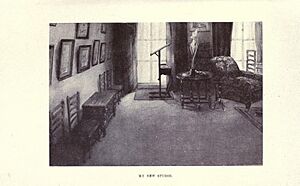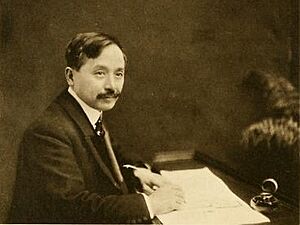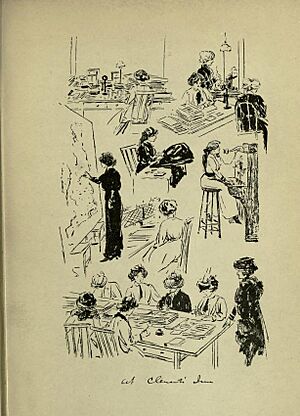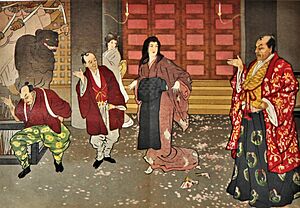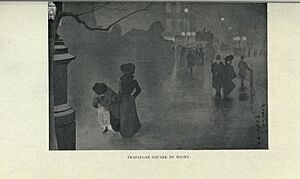Yoshio Markino facts for kids
Quick facts for kids
Yoshio Markino
|
|
|---|---|

Yoshio Markino c.1920
|
|
| Born | 25 December 1869 Koromo, Toyota, Aichi, Japan
|
| Died | 18 October 1956 (aged 86) Japan
|
| Occupation | Artist, Writer |
| Known for | Watercolours, Illustrations |
|
Notable work
|
A Japanese Artist in London (1910), |
| Spouse(s) |
Unknown
(m. 1922) |
Yoshio Markino (born Makino Yoshio, 25 December 1869 – 18 October 1956) was a Japanese artist and writer. He lived and worked in London from 1897 to 1942.
Contents
Yoshio Markino's Life Story
Yoshio Markino was born in Koromo, Japan. His birth name was Makino Heijirō. He was the youngest of three children. His father, Makino Toshimoto, started and taught at the Koromo Primary School. His grandfather was an artist named Bai Yen. The Makino family was an old samurai family. Samurai were a special class of warriors in Japan. However, this class was ended by 1873.
In July 1875, Yoshio started school in Japan. He finished in October 1883. He then taught at the Otani School. When he left this job, he was adopted by the Isogai family, who were distant relatives. His name changed to Makino Yoshio. He then worked at Hagiwara Primary School. Later, he moved to live with his father in Toyoaki City. In 1886, he became an assistant teacher at Haruki Primary School. He lived and worked with his brother Toshitarō.
While there, he began to learn English and study Chinese classic books. In November 1887, he started studying at the Nagoya Eiwa School. He received a scholarship from American Protestant missionaries. In 1889, he tried to join the military but was not accepted. In 1890, he borrowed money from his sister. This allowed him to stay in Yokohama with his cousin Hotta Maki. He graduated from Nagoya Eiwa that summer.
In March 1901, the Naval Inspector's Office in London closed. This was because they had finished ordering warships for Japan. Markino was offered a free trip back to Japan. However, he decided to stay in London. He spent most of his life and career there. He used the money for his trip on art supplies and rent instead.
From late 1910, he traveled with Christabel Pankhurst. She was a leader in the suffragette movement. They gave talks about women's right to vote in the United Kingdom.
Markino changed his name to "Markino" to make it easier for English speakers to say. This helped people not mispronounce it as "Maykino."
In 1922, he married a young French woman named Marie. She had asked him for help with her home life. They got married and moved to New York and Boston. Their marriage ended in 1927. Markino said their relationship was "like sister and brother."
Markino's Art Journey
Art in Japan
In 1880, Yoshio began to study Bunjinga painting with his brother. They studied under Tamegai Chikko until October 1883. In 1886, he started learning Yōga (Western-style) sketching. His teachers were Nozaki Kanekiyo and Mizuno Manji. In October 1887, he began working as a designer for the Nagoya Design Company.
In 1952, he went to a party at the British Embassy in Tokyo. He gave British diplomats a copy of his woodblock print, Thames Embankment in Winter.
Art in the United States
Markino was very interested in Western culture. He left Japan from Yokohama on a ship called The Peru. In 1893, at age 24, he got permission to travel to the United States. He arrived in San Francisco in July 1893 to study art. He got help from Suzuki Utsujirō, the Japanese Consul in San Francisco. Suzuki encouraged Markino to follow his dream of being an artist.
In November 1893, Markino started classes at the Mark Hopkins Institute of Art. In 1894, he learned that his father had passed away. In April 1895, the writer Yone Noguchi visited Markino. During this time, Markino perfected his "silk veil" technique. This allowed him to paint the thick fog of San Francisco in his watercolors.
In June 1897, he traveled to New York. There, he met Miyake Katsumi, another artist.
Between 1893 and 1897, Markino worked many different jobs. He faced unfair treatment because he was Japanese. People sometimes treated him badly in public in California. This was because there was a lot of anti-Japanese feeling there. He told a reporter that he found "Christian hypocrisy" worse in America than in England. He said people would avoid him if he said he wasn't a Christian.
He also had few chances to succeed because of his background. He found it hard to get good jobs. He worked as a house-boy for very little money. His first employer even refused to learn his Japanese name. They just called him "Charlie."
Between 1923 and 1927, he lived in North America. He completed his work "The Plaza Hotel, New York City" (1924) during this time. He also wrote essays. He still had trouble selling his art, so he went back to London.
Art in France
In November 1897, Markino traveled from New York to Paris. He hoped to meet Hayashi, a Japanese art dealer. But Hayashi had already gone back to Japan. Markino returned to Paris in August 1907. His publishers asked him to create art for his book The Colour of Paris. He stayed until June 1908. During this time, he met the famous sculptor Auguste Rodin. He visited Paris again from May to June 1909.
Art in the United Kingdom
In December 1897, Markino decided to move to London. He got this idea from Ide Umataro, an artist he had met. From 1898, Markino worked in the Japanese Naval Inspector's Office during the day. At night, he studied at the South Kensington College of Science. In March 1898, he started studying at the Goldsmith Technical College. In 1900, he moved to the Central School of Art and Design. He worked there as an artist's model. For three months, he designed tombstone markers. However, he stopped because his angels looked like "ballet dancers." This offended some religious people.
He was very poor and often visited publishers looking for daily work. He walked everywhere because he had no money for public transport. He lived on "Bovril and rice." He had a studio at 39 Redcliffe Road, South Kensington, but lived in Brixton.
Markino felt very down because of his money problems. But then, Henry Wilson encouraged him. Wilson loved Japanese art. He promised to introduce Markino to Charles Holmes. Holmes was the editor of The Studio magazine.
In November 1901, Markino's works were published in The Studio. This introduced him as an artist. In December, he met Hirobumi Ito, an important Japanese statesman. By October 1902, Markino's art became popular. He published The Japanese Dumpy Book and works in King Magazine. From November 1902, he lived with Noguchi in Brixton. At this time, Markino often had very little money. In 1903, his work appeared in The English Illustrated Magazine. He also illustrated Noguchi's book From the Eastern Sea. The editor of the Magazine of Art, Marion Spielmann, liked Markino's sketches. Spielmann helped him a lot. He introduced Markino to many people and encouraged him to draw, paint, and write. He also introduced him to Douglas Sladen. Sladen often invited Markino to his home for tea and art parties.
In 1904, the artist Hara Bushō moved in with Markino until May 1905. In September 1905, Markino was chosen to represent British Art at the Venice Great Art Exposition. He also became a research student for national museums in Britain.
In 1906, his illustrations of London were published in The Colour of London. This book was highly praised. He held an exhibition of his works in Clifford Gallery. From May to June, he was in the hospital due to a stomach operation.
In 1908, his books The Colour of Paris and The Colour of Rome were published in England. After traveling, he returned to London in September 1909. He worked on his next book, Oxford from Within, staying in Oxford for research. In 1910, A Japanese Artist in London and Oxford from Within were published. He guided friends around the Japan–British Exhibition. He was also listed in Who's Who until 1949. In 1911, he released a watercolor of Windsor Castle for Queen Mary's coronation. In 1912, The Charm of London was published. In 1915, he helped design the stage for Madame Butterfly at the London Opera House.
From 1918 onwards, he studied Greek, Latin, and English history. He continued to write, paint, and give lectures. His popularity decreased after his friends died in World War I. He married and moved between countries from 1923 to 1927. When he returned to London, he found that all his belongings had been stolen. He managed to set up another exhibition and sell his watercolors. However, he was seen as old-fashioned because he had been away from the art scene. He then lived a free-spirited life with his English and Japanese friends.
Markino loved England very much. He only returned to Japan in 1942 because of World War II. This was when England declared war on Japan. In 1952, in Kamakura, he met Carmen Blacker. She was studying Buddhism there. He was 83 years old, wearing a paint-stained shirt, and carrying a sketchbook. He talked for almost four hours in English and Japanese. He said how happy he had been in London and that he never wanted to leave. He had many friends and loved sketching people and painting the mists.
Art in Italy
Markino lived in Rome from October 1908 to May 1909. He was illustrating The Colour of Rome. From July to October 1910, he stayed with his friends the Sladens and Olave Potter. He was researching for his illustrations of A Little Pilgrimage in Italy. People said Olave and Markino had a romantic relationship.
Markino's Writings
Among his friends were writers like Yone Noguchi. Noguchi introduced him to Arthur Ransome and M. P. Shiel. He also knew the artist Pamela Colman Smith. Markino played an important role in Ransome's book Bohemia in London, even though he wasn't named. He is also thought to be the main character in Shiel's book The Yellow Wave (1905). This book was a sad love story set during the Russo-Japanese War of 1904–1905.
The English Review asked him to write a series of essays. He also wrote a weekly column for the Evening News in 1910. In 1911, he wrote another column for Daily News. Markino's writing skills were noticed. With help from friends like Douglas Sladen, he published several books about his own life. These included A Japanese Artist in London (1910), When I was a Child (1912), and My Recollections and Reflections (1913). British readers liked Markino's writing style and his unique sense of humor.
His writings also supported the suffragette movement. He had many female friends. His book Idealised John Bullesses and his life stories often mention his support for women's marches and suffragettes like Christabel Pankhurst. In 1912, Sarah Grand said he was "a thorough gentleman" after reading his writing. Another friend, Flora Roscoe, invited him to stay in Wedhampton in 1912. She knew Markino disliked business, which he thought the English took too seriously. He sketched the area and later traveled to Salisbury.
Here's a funny story about Markino meeting the dancer Adeline Genée: I had an appointment with Adeline Genée to meet her by the stage entrance of the Empire some years ago; my friend was with me when I went there. I was going to interview her by some paper's request. I was sitting by the stage entrance when I soon found a lady no longer young nor beautiful; she was, however, a most delightful person to talk with. How anxious I was to get rid of her as I had an important work of seeing Adeline Genée. Strangely enough she was quite composed, with no visible intention of leaving me alone; my friend who saw me slightly tired and disinterested, asked me loudly if I wished to leave the place. I jumped up and explained; "Why, I must see Madame Genée!" My friend began to laugh almost wildly and exclaimed again: "Markino, you have been talking there with Madame Genée more than half an hour.
Markino's Stage Work
In 1900, he saw kabuki performances by Otojirō Kawakami in London. In December 1903, Markino helped with costume and set design for Kamigami no Choji. This play was performed at Her Majesty's Theatre. He also designed the theater program.
In 1915, he helped produce a season of Russian, French, and Italian opera at the London Opera House. Vladimir Rosing directed it. This season included the first performance by Japanese singer Tamaki Miura. She sang as Cio-Cio-San in Madama Butterfly.
Markino's Art Style
Markino was a popular member of a group of Japanese artists living in London. This group included Urushibara Mokuchu, Ishibashi Kazunori, Hara Busho, and Matsuyama Ryuson. He was known for his childlike charm and ways. Hara Basho once said to him: There are thousands of artists who can use their brushes better than you. Then why do all your English friends admire your work so much? Because of your own personality You are very faithful to everybody and everything. This nature of yours appears quite unconsciously in every picture of yours. Indeed, some of your pictures are full of faults—but very innocent and delightful faults, which make me smile. ... [to which Markino] exclaims: "But don't you see how poor is my art: Who am I after all? Proper name for me is an art lover."
In 1910, at his exhibit in Whitechapel, art critic Laurence Binyon talked about Markino's use of colors. He noted that Markino used colors popular in Europe but less valued in Japan. Binyon wished for an exhibition that showed the full range of Japanese art.
Mist in Art
Markino was not happy with the fogs in San Francisco. He moved to London to "study London mists." Markino said, "When I came to London first, I thought the buildings, figures, and everything in the distance, looked comparatively large, because in Japan the atmosphere is so clear that you can see every small detail in the distance, while here your background is mystified abruptly, which has great charm to me." His favorite mist was the "gentle mist" that made London "a city of romance." He also loved its "autumn mist." He believed, "London looks ten times nicer if you see her through the mist."
Markino used oil paints and blended primary colors to create his "silk veil technique." He said, "I can achieve a very soft colour by mixing in oils the strongest primary colour with its opponent colour . . . I made many other discoveries and was able to achieve some sense of light while trying to draw a silken veil."
Fog in Art
Markino enjoyed the wet and foggy London street scenes. These were popular in Japanese art. He also liked the paintings of J. M. W. Turner. He eventually grew to love "thick fogs." He said, "A gaslight shining on a wet pavement in a fog is a miracle of beauty; it is like a pool of molten gold." He also liked how "wet pavements reflect everything as if the whole city was built on a lake." Markino used his silk technique to show the changing, heavy fogs of London. These fogs came from the factories of the industrial revolution. They had many different tones and colors. Londoners called them "pea-soupers" when the air turned yellow and green and "stuck" to shiny surfaces.
Mixing Styles
Markino combined Japanese and Western art techniques. He would sketch outdoors (called plein air) or from memory. Drawing from memory was more common in Japanese art. He noted, "I always work out entirely from the impression I get on the street so that sometimes it looks quite in the Japanese style, and other times quite European ... every day I come back from street study I always draw out all the figures I have seen during the day (from notebook or from memory) ... to make a finished picture I compose all those figures."
In traditional Japanese art, seasons are very important. In London, winter was Markino's favorite season. He loved how snow changed the everyday look of London. He said, "that house in front of my window is painted in black and yellow. When I came here last summer I laughed at its ugly colour. But now the winter fog covers it, and the harmony of its colour is most wonderful." He also noted, "Then no matter what ugly colours you may make your houses, if they pass through only one winter, the London fogs would so nicely greyly them always!"
Many of his artworks are kept at the Museum of London. When H. G. Wells bought Markino's work, he said, "I want to carry London to my Paris flat and this picture is the concentrated essence of London."
Illustrated Works
-
Reading in Kensington Gardens (1912)
Books by Yoshio Markino
- There was a little man and he had a little gun (1902)
- Japanese Dumpty (1903)
- From the Eastern Sea (1903)
- The Colour of London (1907)
- The Colour of Paris (1908)
- The Colour of Rome (1909)
- A Japanese Artist in London (1910)
- Oxford from Within (1910)
- A Little Pilgrimage in Italy (1911)
- Idealised John Bullesses (1912)
- The Charm of London (1912)
- When I was a child (1912);
- Recollections and Reflections of a Japanese Artist (1913)
- Twenty years of my Life (1913)
- The Story of Yone Noguchi (1914)
- Confucian Discipline (1936)



